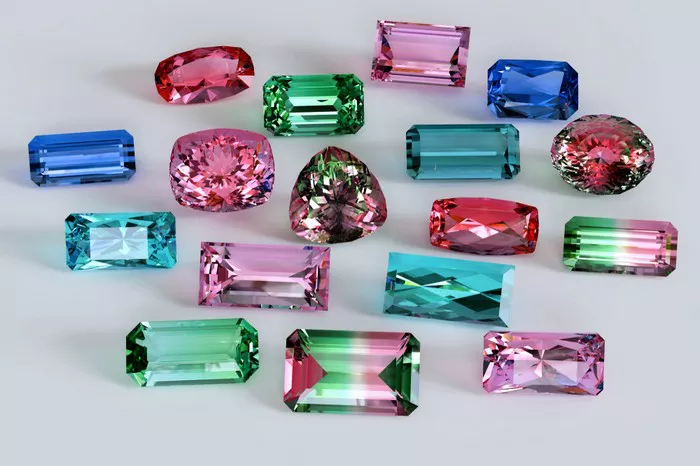Tourmaline, also known as the “mixed gemstone” due to its rich and diverse colors, holds a special place as the official birthstone for October. It is a complex borosilicate mineral with various coloring elements in its chemical composition, contributing to its wide range of hues. In this article, we will explore the characteristics, history, and, most importantly, the value of tourmaline in a detailed, logical, and easy-to-understand manner.
The Characteristics of Tourmaline
Chemical Composition and Color Range
Tourmaline is a complex borosilicate mineral, primarily composed of silicon, boron, aluminum, magnesium, sodium, lithium, and oxygen, with trace elements such as manganese, iron, titanium, and chromium contributing to its diverse colors. These elements are responsible for the wide range of hues found in tourmaline, from deep reds and blues to greens, pinks, and even multi-colored varieties.
Physical Properties
Tourmaline has a hardness of 7 to 7.5 on the Mohs scale, making it suitable for jewelry that can withstand daily wear and tear. Its high transparency and vitreous luster add to its appeal. Tourmaline can be found in various shapes and sizes, from small crystals to large gemstones suitable for cutting and polishing.
Unique Properties
Tourmaline is known for its piezoelectric and pyroelectric properties. Piezoelectricity means that tourmaline generates an electric charge when pressure is applied, while pyroelectricity refers to its ability to generate electricity when heated or cooled. These unique properties have made tourmaline useful in various scientific applications, such as measuring pressure changes and light intensity.
The History and Cultural Significance of Tourmaline
Historical Background
Tourmaline has been valued for its beauty and unique properties for centuries. In ancient times, it was believed to have magical and healing powers, and was often used in talismans and amulets. The name “tourmaline” is derived from the Sinhalese word “toramalli,” meaning “mixed stones,” reflecting its colorful nature.
Popularity in Jewelry
Tourmaline’s popularity as a gemstone surged in the late 19th and early 20th centuries, particularly among royalty and the upper classes. Notably, Queen Victoria of England was a great admirer of tourmaline, and her love for the gemstone contributed to its increasing popularity. In China, tourmaline was mentioned in the Qing Dynasty book Shi Ya, indicating its presence in Chinese culture for centuries.
October Birthstone
Tourmaline’s association with the month of October began in the early 20th century, when it was officially designated as the birthstone for those born in this month. This designation has helped solidify tourmaline’s status as a popular and meaningful gemstone.
The Value of Tourmaline
Factors Influencing Value
The value of tourmaline is determined by several factors, including color, clarity, cut, carat weight, and rarity.
Color: Tourmaline’s vibrant and diverse colors are a significant factor in its value. Red, pink, and blue tourmalines are particularly sought after, with deeper and more intense colors commanding higher prices. The “Paraíba” tourmaline, known for its neon blue-green hues, is one of the most rare and valuable varieties.
Clarity: Like many gemstones, tourmaline’s clarity affects its value. Gemstones with fewer inclusions and better transparency are more valuable.
Cut: The quality of the cut can significantly enhance a tourmaline’s brilliance and sparkle, making it more appealing and valuable.
Carat Weight: Larger tourmalines are generally more valuable, as they are rarer and more difficult to find.
Rarity: Some tourmaline varieties are rarer than others, such as the Paraíba tourmaline, which fetches extremely high prices due to its scarcity.
Price Range
The price of tourmaline can vary widely depending on the above factors. Generally, tourmaline prices range from relatively affordable to very high, catering to different budgets and tastes.
Affordable Varieties: Tourmalines with lighter colors, smaller sizes, or more inclusions are typically more affordable. These gemstones can still be beautiful and make excellent jewelry choices for those on a budget.
Mid-Range Varieties: Many tourmalines fall into the mid-range price category. These gemstones may have more intense colors, better clarity, and larger sizes, making them suitable for those who want a high-quality gemstone without breaking the bank.
High-End Varieties: The rarest and most desirable tourmalines, such as Paraíba tourmalines, can fetch extremely high prices. These gemstones are highly sought after by collectors and investors due to their scarcity and unique beauty.
Market Trends
The demand for tourmaline has been relatively stable over the years, with occasional spikes in popularity due to fashion trends or celebrity endorsements. As with any gemstone, the market for tourmaline is influenced by supply and demand dynamics, as well as global economic conditions.
Conclusion
Tourmaline, as the October birthstone, holds a special place in the world of gemstones. Its vibrant colors, unique properties, and rich history make it a popular choice for jewelry and a meaningful gift for those born in October. The value of tourmaline can vary widely depending on various factors, from color and clarity to cut and carat weight. Whether you’re looking for an affordable gemstone to complement your outfit or a rare and valuable investment piece, tourmaline offers a wide range of options to suit your needs and preferences.
Related topic:
- What Kind of People like Rose Quartz and Black Tourmaline Necklace?
- Why Is Black Tourmaline Powerful
- Where Is the Best Place for Black Tourmaline?


